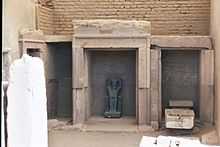Heqaib
| Heqaib Nomarch of the 1st nomos of Upper Egypt | |
|---|---|
|
Entrance of the tomb of Heqaib at Qubbet el-Hawa. | |
| Dynasty | 6th dynasty |
| Pharaoh | Pepi II Neferkare |
| Burial | Qubbet el-Hawa |
Heqaib, also Hekaib or Hekayeb, was an ancient Egyptian nomarch of the 1st nomos of Upper Egypt ("Land of the Bow") under king Pepi II Neferkare, towards the end of the 6th dynasty. He was also an officer in charge of military expeditions.
Biography
| |||||||||||
| Pepinakht[1] in hieroglyphs |
|---|
His real name was Pepinakht (ppjj-nḫt - "[King] Pepi is strong"[1]). As officer, he led at least three expeditions. All of these are registered on the facade of his tomb at Qubbet el-Hawa (near Aswan), after a long list of his titles.
In the first expedition, Pepinakht led a surprise attack in the lands of Wawat and Irthet, slaining many warriors and taking many prisoners to the court of the pharaoh. Then, he was sent back to the same places (second expedition) where he captured some chieftains, and also brought back a booty.
For his third expedition, Pepinakht was instructed to bring back the corpse of Enenkhet; he was an expedition leader in charge to build a ship to reach the Land of Punt, but he was attacked and killed along with his escort by the "sand dwellers".
Pepinakht's autobiography abruptly ends while he was attacking the "sand dwellers". However, it's very likely that he was able to accomplish even this mission. His capabilities and charisma earned him the nickname Heqaib (ḥq3-ỉb - "He who controls his heart"[2]) and then, after his death, his divinization.
| ||||||
| Heqaib[3] in hieroglyphs |
|---|

Heqaib's quick deification may be representative of the great power achieved by local authorities in this period, which is a prelude to the forthcoming collapse of the Egyptian state.[4]
Shortly after his death, he started to receive a massive worship initially in front of his tomb, and later in a dedicated sanctuary: many monuments of kings, nomarchs and commanders were found in the shrine and are dated from the 11th to the 13th dynasty. The sanctuary was later abandoned until its rediscovery by Edouard Ghazouli and Labib Habachi.[2]
References
- ↑ 1.0 1.1 Hermann Ranke, Die ägyptischen Personennamen, Band 1, Augustin, Glückstadt, 1935, p. 132.
- ↑ 2.0 2.1 Labib Habachi, Heqaib. in: Wolfgang Helck, Eberhard Otto, Lexikon der Ägyptologie. vol 2. Harrassowitz, Wiesbaden 1977, ISBN 3-447-01876-3, pp. 1120–22.
- ↑ Herman Ranke, op. cit. p. 256.
- ↑ Nicolas Grimal, A History of Ancient Egypt, Oxford, Blackwell Books, 1992.
| Wikimedia Commons has media related to Heqaib. |
Bibliography
- James Henry Breasted, Ancient Records of Egypt, vol 1, The University of Chicago Press, 1907, §§ 355-360.
- Labib Habachi, The Sanctuary of Heqaib (= Elephantine 4 = Archäologische Veröffentlichungen. (AV). Bd. 33). 2 voll, von Zabern, Mainz 1985, ISBN 3-8053-0496-X.